Friedreich Ataxia, a Simple Guide to the Condition, Diagnosis, Treatment and Related Conditions
ebook
By Kenneth Kee

Sign up to save your library
With an OverDrive account, you can save your favorite libraries for at-a-glance information about availability. Find out more about OverDrive accounts.
Find this title in Libby, the library reading app by OverDrive.



Search for a digital library with this title
Title found at these libraries:
| Library Name | Distance |
|---|---|
| Loading... |
Friedreich ataxia is a rare disease and the most frequent inherited ataxia.It is a degenerative disorder that mainly affects the nervous system, muscles and the heart.It is often linked with cardiomyopathy or diabetesThere is progressive ataxia (in-coordination of muscles), dysarthria, reduced proprioception, vibration sense and muscle weakness.The inheritance is autosomal recessive.CauseThe gene disorder is a mutation of the frataxin gene (FXN) on chromosome 9.Many patients (98%) have a GAA repeat expansion of the frataxin gene with the size of the expansion correlating with the severity of the diseaseMore infrequently there is a point mutation in one gene.The mutation leads to reduced synthesis of frataxin, a mitochondrial protein.Its poor function leads to mitochondrial dysfunction and oxidative injury to cellsThe cellular injury mainly involves the nervous system and the heart (for unknown reasons).The sensory neurons affecting proprioception are involved early and severely so ataxia is an early feature of the disease.SymptomsFriedreich's ataxia is a progressive neurodegenerative disorder, normally with start before 20 years of age.Signs and symptoms are:1. Progressive ataxia,2. Ascending weakness and3. Ascending loss of vibration and joint position senses,4. Pes cavus,5. Scoliosis,6. Cardiomyopathy, and7. Cardiac arrhythmiasSymptoms most often begin before puberty.Symptoms may include:1. Abnormal speech2. Changes in vision, particularly color vision3. Decrease in ability to feel vibrations in lower limbs4. Foot problems, such as hammer toe and high arches5. Hearing loss, this occurs in about 10% of people6. Jerky eye movements7. Loss of coordination and balance, which leads to frequent falls8. Muscle weakness9. No reflexes in the legs10. Unsteady gait and uncoordinated movements (ataxia), which gets worse with timeMuscle disorders result in changes in the spine.This may lead to scoliosis or kyphoscoliosis.Heart disease most often forms and may result in heart failure.Diagnostic investigations1. Nerve conduction studies show motor velocities >40 ms-1 in arms and absent sensory action potentials.2. Genetic analysis.3. ECG - there may be ventricular hypertrophy and T-wave inversion.4. Vitamin E deficiency is excluded.Further investigations1. Blood tests: FBC, U&E and glucose2. Echocardiography may indicate ventricular hypertrophy, septal hypertrophy and hyper-trophic cardiomyopathy.3. MRI scan of the brain and spinal cordTreatmentFriedreich ataxia is a disease with multi-system participation.Annual reviews should have evaluation of:1. Neurology,2. Cardiac function,3. Musculoskeletal disorders,4. A comprehensive systems review and5. Blood tests (hematology and monitoring for diabetes).Supportive treatment1. Physiotherapy.2. Speech and language therapy.3. Occupational therapy.System Treatments:1. Treatment of cardiac failure and arrhythmias is using standard treatments.2. Orthopedic surgery if there are problematic symptoms from scoliosis, pes cavus or equinovarus deformity of feet.3. Foot deformities may also be assisted by botulinum toxin or splints.4. Passive exercises and warming are required for peripheral cyanosis and cold feet.5. Diabetes will normally require insulin.6. Sphincter dysfunction symptoms (e.g., urgency)7. Urodynamic assessment and treatments8. Sexual dysfunction may need symptomatic treatment.9. Counseling or antidepressants for depressionTreatment for Friedreich ataxia is:1. Counseling2. Speech therapy3. Physical therapy4. Walking aids or wheelchairs5. Idebenone and interferon-gamma medical treatmentTABLE OF CONTENTIntroductionChapter 1 Friedreich AtaxiaChapter 2 CausesChapter 3 SymptomsChapter 4 DiagnosisChapter 5 TreatmentChapter 6 PrognosisChapter 7...







